E-learning has become an increasingly popular education in recent years and for good reason. With the correct planning and implementation, e-learning programs can be highly effective in engaging students, improving learning outcomes, and addressing issues of equity and access. However, creating a successful e-learning program requires careful consideration and planning. Here is a guide for educators and administrators looking to develop a successful e-learning program.
- Define your goals and objectives: What do you hope to achieve through your e-learning program? What learning outcomes do you want to see? By specifying your goals and objectives, you can ensure that your e-learning program is focused and effective.
- Choose the right technology: The success of your e-learning program will depend on the technology you choose. There are a variety of e-learning platforms and tools available, so it’s essential to select the ones that will meet the needs of your students the best.
- Develop high-quality content: The content of your e-learning program is critical to its success. Ensure your content is high-quality, engaging, and aligned with your learning objectives. Consider incorporating multimedia elements such as videos, interactive activities, and simulations to make your content more engaging.
- Provide opportunities for interaction and collaboration: One of the benefits of e-learning is that it can provide opportunities for interaction and cooperation among students and instructors. You should ensure that your e-learning program includes options for students to interact with each other and with instructors, whether through discussion forums, group projects, or other collaborative activities.
- Assess and evaluate student progress: To ensure that your e-learning program is effective, you should assess and evaluate student progress. This can include tracking student participation and engagement, monitoring student performance on assignments and assessments, and soliciting student feedback.
- Support and resources: Finally, providing support and resources to students is crucial to ensure they succeed in your e-learning program. This may include technical support, tutoring services, and access to online resources and materials.
Successful e-learning programs require careful planning, implementation, and ongoing evaluation. By following these guidelines, educators and administrators can create e-learning programs that are engaging, effective, and promote student success.
